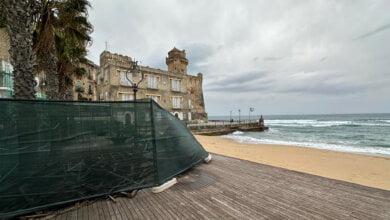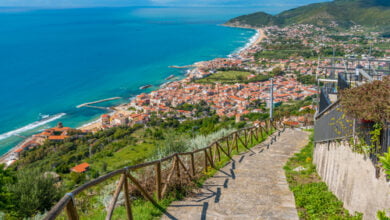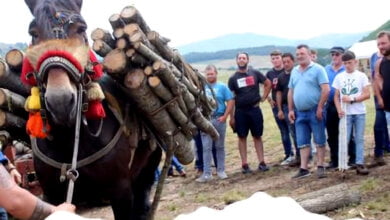
San Severino di Centola, also known historically as San Severino di Camerota, is an abandoned medieval village located in the Italian region of Campania, within the National Park of Cilento. The village, founded between the 10th and 11th centuries, is located on a hill and was originally an important strategic center for controlling the valley below.

La Sanseverino family
La Sanseverino family it had a notable influence in Southern Italy, particularly in the territories that today are part of the regions of Campania, Basilicata, Calabria and Puglia. Originally the Sanseverinos emerged as one of the most powerful noble families in the Kingdom of Naples, coming to own over 300 fiefdoms, including counties, marquisates, duchies and principalities. Their connection with San Severino di Centola dates back to the early medieval period when the village was one of the many fiefdoms under their control.

The Sanseverino house traces its origins to the Norman knight Turgisio, a descendant of the ducal family of Normandy, who received the county of Rota, today known as Mercato San Severino, as a gift from Robert Guiscard. This location had an important strategic position, being a connection point between the Principality of Salerno and the Duchies of Naples and Benevento. Turgisio chose to settle in the castle of Sanseverino, located in his new territories, and adopted the name of this place as the family surname. Despite challenges, including attacks by the Swabians and Durazzo that nearly caused their destruction, the Sanseverinos demonstrated resilience, maintaining their loyalty to the Pope and the Guelph party, and managing to regain their former splendor.

In the 15th century, the family split into the two main branches of Salerno and Bisignano, as well as numerous other minor branches, including the counts of Lauria, the dukes of Scalea, the dukes of San Donato, the counts of Tricarico, the counts of Caiazzo, the counts of Colorno, the barons of Calvera and the barons of Marcellinara. The Sangineto families, originally settled in Naples and Calabria, and the Lauro family, present in Amantea, Tropea, Cosenza and Naples, also descended from the Sanseverino family. These family branches took their name from the respective fiefdoms of Sangineto and Lauro.
The Sanseverinos received semi-sovereign treatment in the Kingdom of Naples. This is demonstrated by the privilege, granted to the Sanseverinos and confirmed to the house by Charles V in 1520, according to which in the absence of a male heir the fiefdoms were never to be dispersed through female succession, as they had to pass to the closest male relative:
«in quantumcunque remotus etiam tenth and further degrees ex quacumque transversal line, ascending and descending [...] And inter ipsos of surname of Sancto Severino progenitura and gradus servitur»
wikipedia
In fact, in 1606, with the death of the prince of Bisignano, Nicolò Bernardino Sanseverino, who had no direct heirs since his only son had predeceased his father, the fiefdom passed to his niece Giulia after a long legal dispute at the Royal Court of Naples. Upon Giulia's death, the privilege was restored and Luigi Sanseverino, count of Saponara and sixth cousin, was recognized as heir. The situation was different for the county of Tricarico, which was auctioned by sovereign will, thus depriving the Sanseverino family of the main source of income.

The town of San Severino
Founded between the 10th and 11th centuries, it preserves traces of different historical eras, including the twentieth century, with ruins of a castle and a church. According to the humanist Pietro Summonte, the name of the village derives from the Sanseverino family, one of the most powerful and richest in the Principality of Salerno during the Norman era and subsequently in the Kingdom of Naples under the Angevins and the Aragonese. However, Giuseppe Antonini and other scholars argue the opposite, stating that it was the family that took its name from the village.

The origins of the settlement date back to the 7th century, when Bulgarian mercenaries led by Prince Aztek settled in the area, as documented by Paolo Diacono in “Historia Langobardorum”. These mercenaries controlled the gorge of the Mingardo and the main communication route towards the Gulf of Policastro, essential for the connection with the port of Palinuro. The village had great strategic importance for the Lombards, as demonstrated by the dispute in 1075 between Count Guido di Policastro and Guimondo dei Mulsi. After a bitter fight, which saw Guido's assassination, the village was finally assigned to Landolfo, Guido's brother.

With the arrival of the Normans and subsequently the Swabians, the village was further fortified, especially by Frederick II. During the War of the Vespers, San Severino suffered serious damage due to the raids of the Almogaveri, so much so that Charles II of Anjou exempted the town from paying taxes in 1291.
Under Aragonese rule, starting from 1444, the village lost its strategic importance and fell into decline. In 1552, following conflicts with Charles V, the Sanseverinos were exiled from the Kingdom of Naples and their fiefdom was sold. Over the centuries, the village underwent various changes of ownership until the abolition of feudalism in 1806.

The village suffered a progressive abandonment, especially after the construction of the railway line Pisciotta – Castrocucco in 1888, which encouraged the transfer of the population downstream. However, until 1977, the village church remained the point of reference for the population of the valley and some houses were still inhabited.
Two branches of the Sanseverino family: the Barons of Cilento and the Princes of Salerno
The founder of the Barons of Cilento, Turgisio, died in 1081 and was followed by Ruggero, who after being widowed retired as a Benedictine monk to the Badia di Cava, making important donations. Ruggero had two sons: Roberto, lord of Lauro, and Enrico, lord of Sanseverino and Cilento.
Among Roberto's descendants, Ruggero Sanseverino, count of Tricarico stands out, who in 1188 contributed to the third crusade with a notable number of men and knights. Riccardo Sanseverino (1220-1267), count of Caserta and imperial vicar of Frederick II, is also an important figure.
Henry's descendants include:
- Guglielmo Sanseverino (1144-1190), who married Isabella Guarna, daughter of Silvestro Guarna, important minister of King William I of Sicily.
- Tommaso Sanseverino (circa 1180-1246), count of Marsico from 1241, took part in the conspiracy against Frederick II and was captured and executed.
- Ruggero Sanseverino (circa 1237-1285), who participated in the battle of Benevento in 1266, which brought the Angevins to power, and was Captain General of Charles I of Anjou.
- Tommaso II Sanseverino (circa 1255-1324), count of Tricarico, who significantly expanded the family's dominions, becoming lord of numerous territories, and founded the Padula charterhouse in 1306.
During the 14th and 15th centuries, the family divided into various branches, including that of Mileto and that of Colorno, maintaining an influential role in the political and military panorama of the Kingdom of Naples.

The princes of Salerno
Roberto Sanseverino, born around 1430 and died in 1474, obtained the title of prince of Salerno in 1463. He married Raimondella del Balzo Orsini and commanded the Aragonese fleet in the battle of Ischia in 1465, event's audience depicted in the famous "Strozzi table", the first aerial representation of the city of Naples. The galleys displayed the colors of the Sanseverino family on the bow and the Aragonese weapons on the stern. Roberto also commissioned the construction of the diamond-pointed ashlar palace in Naples in 1470, now known as the church of Gesù Nuovo.
Antonello Sanseverino, born in 1458 and died in 1499, served as grand admiral of the Kingdom of Naples starting in 1477 and was a key figure in the Conspiracy of the Barons of 1485. He married Costanza di Montefeltro, daughter of Duke Federico of Urbino.
Roberto II Sanseverino, who lived between 1485 and 1509, married Maria of Aragon, daughter of Alfonso, brother of Ferdinand the Catholic.
Ferdinando, or Ferrante Sanseverino, born in 1507 and died in 1572, was the last of the line of princes of Salerno. He opposed the introduction of the Spanish Inquisition and came into conflict with Charles V, who in 1553 put an end to the principality of Salerno. He died in exile in France and, following these events, the assets of the Sanseverino family of Salerno were confiscated and sold, marking a long period of decline for the city.









